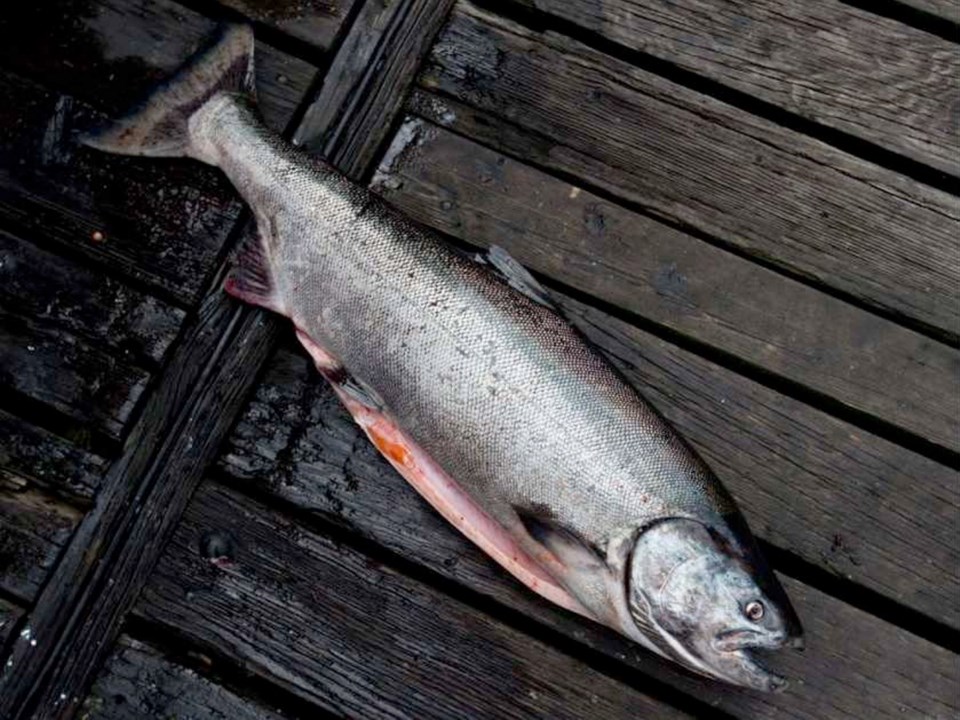An American seafood sustainability program is recommending consumers stop eating salmon caught by four B.C. fisheries that it has “red-listed” over concerns about shrinking chinook and coho populations.
The recommendation comes as there are persistent questions about dwindling Fraser River sockeye returns, which have been in decline for the past decade.
In the latest update to the Monterey Bay Aquarium’s Seafood Watch program, four B.C. chinook and coho fisheries were listed as “avoid.” Ten others were identified as having “some concerns,” but remain listed as “good alternatives.”
The four fisheries newly labelled as “avoid” are all in southern B.C. — chinook caught off the south coast using purse seine (a net that is drawn into the shape of a purse to catch large schools of fish) or drift gillnets (vertical sheets of net with certain sizes of netting to capture specific types of fish), and coho salmon in the same region using the same two methods.
“Most fisheries receiving the avoid recommendation have very small catches of coho and chinook salmon that are often taken incidentally in fisheries targeting other salmonids,” said the Seafood Watch update, released Tuesday.
The 10 fisheries listed as “good alternatives” include those along the North and Central coast of B.C., transboundary rivers and the west coast of Vancouver Island.
The report ranks commercial salmon fisheries based on their effect on the species or on other species, their management effectiveness, and their habitat and ecosystem.
According to Jeffery Young, a science and policy adviser with the David Suzuki Foundation, the rating is not necessarily a criticism of a fisheries’ practices, but reflects that the salmon targeted by these fisheries are in serious decline.
“These are fisheries we still have some concerns about but they’ve done basically all they can,” said Young.
Jeremy Dunn, executive director of the B.C. Salmon Fishers Association, agreed with Young’s assessment.
“It doesn’t mean these fisheries are poorly managed, but there are concerns for the stock,” he noted, adding that climate change, which is largely credited as being a reason behind the dwindling wild salmon stock, only points to a bigger need for salmon farms.
According to Dunn, B.C.’s current fish harvest is about 50 per cent farm-raised and is projected to reach 75 per cent in the next two decades.
“Farming is really the only chance, but doing it properly is paramount,” he said.
Young said the decline of chinook could also affect the 83 resident killer whales in southern B.C. waters that rely on chinook as their primary food source. Killer whales are listed as endangered under the Species at Risk Act.
In 2012, retired judge Bruce Cohen issued 75 recommendations after a three-year, $26-million study of the collapse of the Fraser River sockeye fishery in 2009, when only 1.4 million fish returned, despite a projection for 10 million. The study looked at a variety of factors that could be hurting the sockeye population — including climate change and the effect of farmed salmon on wild salmon — and called for the federal government to implement a wild salmon policy and tighter restrictions.
Federal Fisheries Minister Dominic LeBlanc recently said Ottawa had acted on 32 of the recommendations either in whole or in part.
Research is also being conducted to determine if and how salmon farms are affecting wild salmon. And a project involving the Pacific Salmon Foundation, Genome B.C. and the federal Department of Fisheries and Oceans is looking at the high mortality rate of juvenile salmon during early ocean migration.
While many may point the finger at salmon farms as the culprit behind disease spread in wild stocks, Dunn said sustainable farming is necessity to balance demand on wild salmon populations.
“I think the pressure on global fishery stocks is very real and documented and does point to the need for the farming of aquatic species, including salmon, but really points to the need for sustainable farming — which is why our farmers have committed … and believe strongly in not only farming with world best practices, but also third party certification,” said Dunn.
Young hopes is that the benefits expected from implementing all of the Cohen recommendations will not just help sockeye runs, but also chinook and coho — and in turn, help with killer whale populations.
“That’s a lot of what the Cohen Report is about, is looking at things in a more comprehensive way,” he said.



